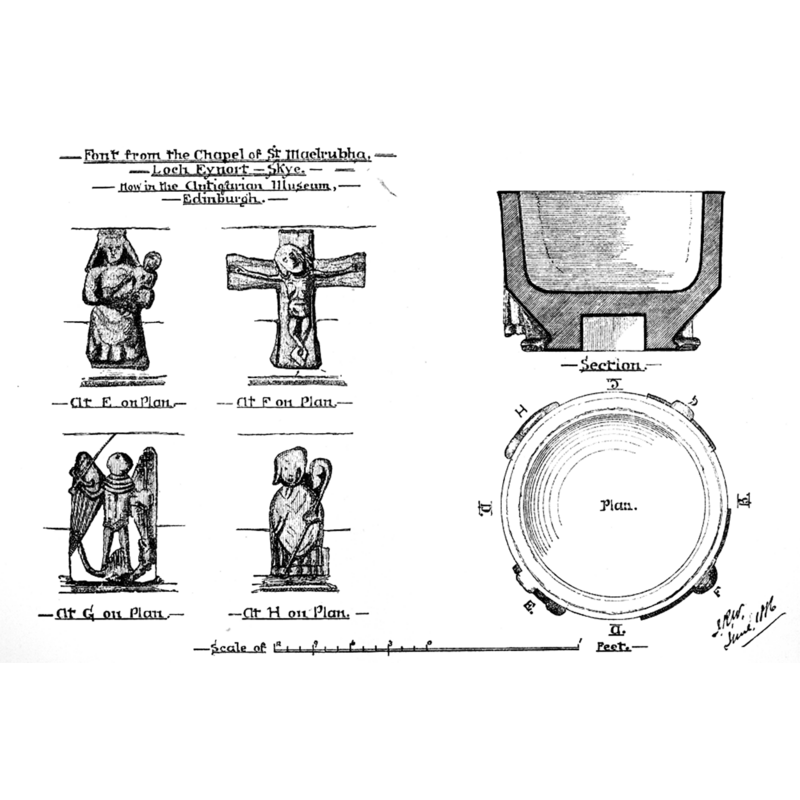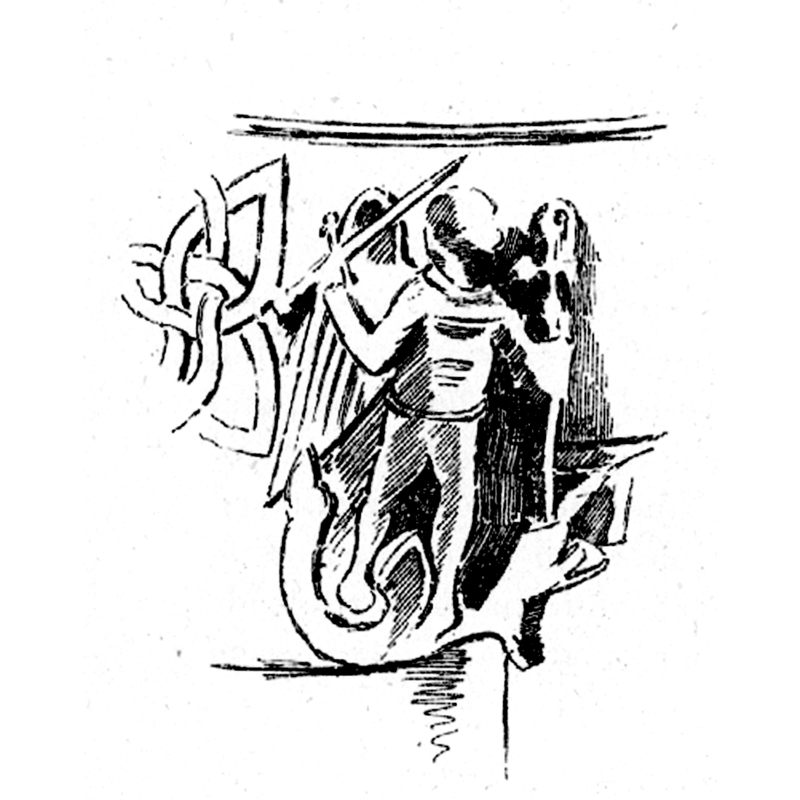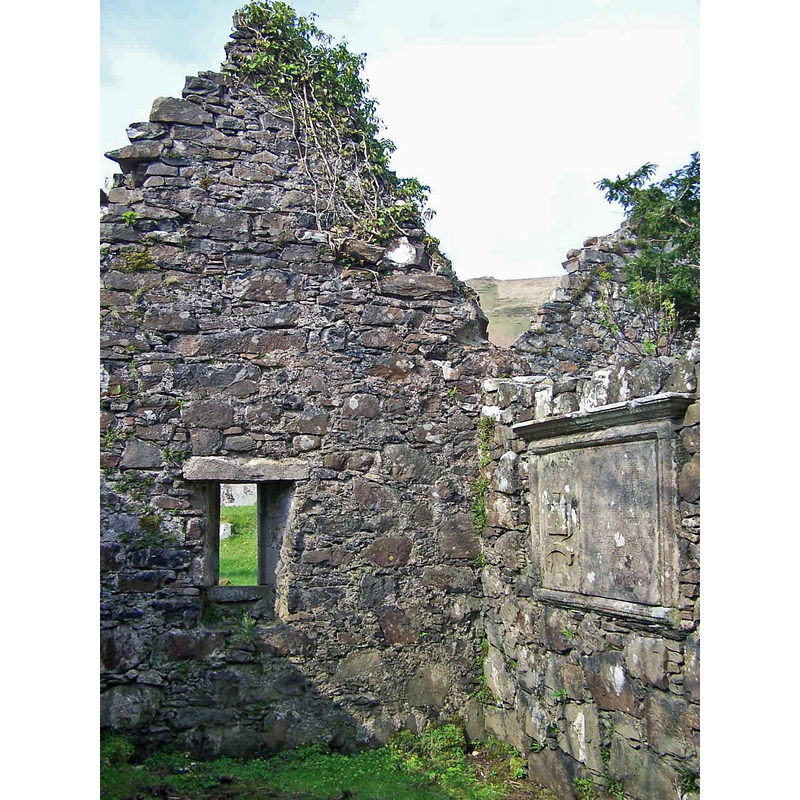Loch Eynort / Aoineart / Kilmolruy / Lochaoineart

Image copyright © [in the public domain]
PD
Results: 24 records
New Testament - Passion of Christ - Crucifixion
Virgin Mary - Madonna and Christ-child
angel - archangel - St. Michael and dragon
cleric - bishop - wearing mitre - with staff in left hand
design element - motifs - floral - rosette
design element - motifs - interlace
design element - motifs - interlace
symbol - tree
symbol - tree
symbol - triquetra
view of basin
Scene Description: This drawing appears on the back pages of MacGibbon & Ross' book (1896-1897); those pages are dedicated to advertisements of the publisher's other books
Copyright Statement: Image copyright © [in the public domain]
Image Source: digital image of an illustration in MacGibbon & Ross (1896-1897: ad page)
Copyright Instructions: PD
view of basin
view of basin
Scene Description: Source caption: "Sculptured Font from Kilmolruy, Loch Eynort, Skye"
Copyright Statement: Image copyright © [in the public domain]
Image Source: digital image of an illustration in Joseph Anderson's Scotland in Early Christian Times (1881) [https://archive.org/details/scotlandinearlyc00anderich] [accessed 23 October 2023]
Copyright Instructions: CC-PD-Mark / PD-old-70-expired
view of church exterior - southwest view
Scene Description: Source caption: "St. Maelrubha's Chapel, Eynort"
Copyright Statement: Image copyright © Richard Dorrell, 2011
Image Source: digital photograph 19 April 2011 by Richard Dorrell https://www.geograph.org.uk/photo/2367167] [accessed 23 October 2023]
Copyright Instructions: CC-BY-SA-2.5
view of church exterior in context
Scene Description: Source caption: "The ruins of a church and chapel stand within a walled cemetery just above the shore of Loch Aynort. There is no road or obvious path to the site [...] The larger building is late 18th century. A font from the church has been removed to the National Museum of Antiquities, Edinburgh."
Copyright Statement: Image copyright © Richard Dorrell, 2011
Image Source: digital photograph 19 April 2011 by Richard Dorrell https://www.geograph.org.uk/photo/2367084] [accessed 23 October 2023]
Copyright Instructions: CC-BY-SA-2.5
view of church exterior in context
Scene Description: Source caption: "St. Maelrubha's Chapel, Eynort. Looking over the wall of the graveyard from the shore of Loch Eynort [...] There was almost certainly a church on this site before the building of the present ruined structures. The small chapel is the older [...] The larger building is late 18th century. A font from the church has been removed to the National Museum of Antiquities, Edinburgh."
Copyright Statement: Image copyright © Richard Dorrell, 2011
Image Source: digital photograph 19 April 2011 by Richard Dorrell https://www.geograph.org.uk/photo/2367115] [accessed 23 October 2023]
Copyright Instructions: CC-BY-SA-2.5
view of church interior - looking west - detail
Scene Description: Source caption: "St. Maelrubha's Chapel, west wall. Viewed from inside, this is the west gable end wall of the chapel."
Copyright Statement: Image copyright © Richard Dorrell, 2011
Image Source: digital photograph 19 April 2011 by Richard Dorrell https://www.geograph.org.uk/photo/2367138] [accessed 23 October 2023]
Copyright Instructions: CC-BY-SA-2.5
view of font
Scene Description: as displayed in the museum [NB: the blog source has the image horizontally rotated -- corrected here]
Copyright Statement: Image copyright © SCRAN, 2023
Image Source: digital photograph from SCRAN.ac.uk, reproduced in The Carmichael Watson Project Blog 29 June 2012 [http://carmichaelwatson.blogspot.com/2012/06/st-michaels-font.html] [accessed 23 October 2023]
Copyright Instructions: PERMISSION NOT AVAILABLE – IMAGE NOT FOR PUBLIC USE
view of font
Scene Description: as displayed in the museum
Copyright Statement: Image copyright © SCRAN, 2023
Image Source: digital photograph in SCRAN [000-100-000-336-C] [https://www.scran.ac.uk/database/record.php] [accessed 23 October 2023]
Copyright Instructions: PERMISSION NOT AVAILABLE – IMAGE NOT FOR PUBLIC USE
view of font
Scene Description: as displayed in the museum
Copyright Statement: Image copyright © SCRAN, 2023
Image Source: digital photograph in SCRAN [000-190-001-090-C] [https://www.scran.ac.uk/database/record.php] [accessed 23 October 2023]
Copyright Instructions: PERMISSION NOT AVAILABLE – IMAGE NOT FOR PUBLIC USE
view of font
Scene Description: as displayed in the museum
Copyright Statement: Image copyright © SCRAN, 2023
Image Source: digital photograph in SCRAN [000-190-001-091-C] [https://www.scran.ac.uk/database/record.php] [accessed 23 October 2023]
Copyright Instructions: PERMISSION NOT AVAILABLE – IMAGE NOT FOR PUBLIC USE
view of font
Scene Description: as displayed in the museum
Copyright Statement: Image copyright © SCRAN, 2023
Image Source: digital photograph in SCRAN [000-190-001-092-C] [https://www.scran.ac.uk/database/record.php] [accessed 23 October 2023]
Copyright Instructions: PERMISSION NOT AVAILABLE – IMAGE NOT FOR PUBLIC USE
view of font
Copyright Statement: Image copyright © Crown Copyright: HES (Ordnance Survey Archaeology Division), 1958
Image Source: digital image of a ca. 1958 record reproduced in CANMORE [SC 2358776 Skye, Eynort, St Maelrubha's Churches, NG32NE 1, Ordnance Survey index card, page number 2, Verso - Records of the Ordnance Survey, Southampton, Hampshire, England c. 1958 © Crown Copyright: HES (Ordnance Survey Archaeology Division)] [accessed 13 February 2025]
Copyright Instructions: PERMISSION NOT AVAILABLE – IMAGE NOT FOR PUBLIC USE
INFORMATION
FontID: 00972LOC
Object Type: Baptismal Font1
Museum and Inventory Number: Antiquarian Museum of Edinburgh
Church/Chapel: Church / Chapel of St. Maelrubha [ruins]
Church Patron Saints: St. Maelrubha [a.k.a. Maree, Maolruidha, Maolruibha, Maolrubha, etc.]
Church Location: [cf. DirectionsGeo field]
Country Name: Scotland
Location: Skye, Eilean Siar / Outer Hebrides
Directions to Site: One of the sources suggests the church located in the Aird of Strath, on Loch Eynort in Minginish, on the NW side -- The Saints in Scottish Place-Names gives the location as Kilmolruy [https://saintsplaces.gla.ac.uk/place.php?id=1320417257] [accessed 23 October 2023] -- the Kilmolruy site ruin is located at the head of Loch Eynort
Font Location in Church: in a museum
Century and Period: Medieval [basin only]
Church Notes: "The following narrative shows how it came into Mr. Carmichael's posession:-- Many years, ago a crew of South Uist fishermen, while on their way to Glasgow with a cargo of fish, were driven into Lochaoineart, Skye. Upon the north-west side, and near the head of Lochaoineart, stand the church and churchyard of St Malrube, the former a roofless ruin, and the latter a deserted wild. Here the fishermen saw an old font, and deeming it to be too sacred to be left with the heretic Protestants of Skye, resolved to bring it to their priest, the late Rev. James MacGrigor. They accordingly carried it to their boat, and, the weather moderating, resumed their voyage. But before reaching the island of Canna the weather again became boisterous, and again forced them back to Lochaoineart. Attributing their misfortune to their removal of the font, a debate arose among the fishermen, whether or not they should restore it to its original position; but the wind becoming fair, it was decided by a majority of the crew to make another attempt, which was accordingly done. But the weather again became stormy, so much so that, south of the Small Isles, they were in imminent danger, and unanimously concluding that the elements were conspiring against them for removing the font, they agreed to return, and replace it. Much angry recrimination now took place. The minority, who were against sailing with the font a second time, abused the makority in no measured terms, and told them that this was what they predicted, and the majority blamed one another. The gale increased, and with it the superstitious fears of the fishermen. Consequently, they returned to Lochaoineart, and, with much care, replaced the font where they found it. The fishermen reached Glasgow, and disposed of their cargo. On their return voyage they again called at Lochaoineart. They still cherished the desire to bring the font to Mr MacGrigor, and they accordingly placed it againin their boat, and, after much misgiving, ventured across the Minch, landed at Tocar, and carried the font in triumph to Mr MacGrigor at Ard-Choinnich. There it lay in a corner of the chapel till a few weeks ago, when it was sent me in a present by my friend, the Rev. Donald Macintosh, the late Mr MacGrigor's sucessor." (In Walker, 1887, p. 412, 417)
Font Notes:
Click to view
The basin of this font is illustrated in Anderson (1881). Described in Walker (1887: 412) as a "fine bowl presented to the Museum [i.e., the Antiquarian Museum of Edinburgh] by Alexander A. Carmichael, Esq., Lochmaddy, trough W.F. Skene, Esq., F.S.A. Scot." [cf. Church notes for further details on its origin]. The basin is all that remains, the base, "four shafts carrying the bowl" (ibid., p. 417) having been left in situ when the font was removed from its original location. The lower part of the basin sides indents with a chamfer. The sides are ornamented with four figures located at 90-degree angles [L->R]: 1)Christ on the cross, the figure on the cross being represented with head inclined to the right, draped round the loins, and the legs crossed; 2)St. Michael slaying te dragon; St. Michael is winged and holds a sword up in his right hand; one foot is placed on the back of the dragon, and the other on its neck; the left hand holds a long cross, the end of which is inserted into the dragon's mouth; 3)bishop figure dressed in full chanonicals, mitred and carrying a staff in his left hand; 4)Virgin with the Child in her arms. The panel to the right of the Crucifixion is filled in with elaborate interlaced work; those to right and left of the bishop with inscriptions now entirely defaced. The lower part of the bowl recedes between the figures, and forms four sloping panels, each of which bears a floral device, where Walker (ibid., p. 417) reckons the shafts of the base would fit. He identifies the stone of the basin as "hornblendic gneiss" and describes the overall work as "beautifully sculptured in very high relief" (ibid.). Illustrated in MacGibbon & Ross (1896-1897), where the font appears mounted on a single pedestal, cylindrical on its upper volume, square on the lower; one of the sides shows traces of an inscription [cf. Iconographical data area below]. The font is noted and illustrated in The Carmichael Watson Project Blog 29 June 2012 [http://carmichaelwatson.blogspot.com/2012/06/st-michaels-font.html] [accessed 23 October 2023]: "One of the larger items in Carmichael's collection is this baptismal font, on display at the National Museum of Scotland, Edinburgh. St Michael's font came from St Maelrubha's chapel, Eynort, Syke and is really spectacular. The carvings depict Christ on the cross, the Virgin and child (above), a bishop 'in full pontificals and crozier' and St Michael slaying a dragon." [sources given in the blog entry: Carmichael, Alexander, 'Donation of baptismal font from Chapel of St maelruve, Lochaoineart, Skye', Proceedings of the Society of Antiquaries for Scotland, vol viii (1868-1870) pp. 237-239. CW104/27 -- Swire, Otta Skye: The Island and its Legends (Edinburgh; Birlinn Limited, 2006)]. The entry for this site in CANMORE [https://canmore.org.uk/site/11030/skye-eynort-st-maelrubhas-churches] [accessed 13 February 2025] notes: "Eynort. Medieval chapel and church at Borline, on an older religious site dedicated to St. Maelrubha. The chapel's thick rubble walls and splayed windows suggest a building of late medieval date, rebuilt after the Reformation (c.1732 ) and used as a burial chapel for the Macleods of Talisker; ruinous by 1792. The church is 17th/early 18th century, with a later large window in its east gable. The site has yielded examples of medieval carving of considerable significance, including a font depicting religious figures and part of an ornately carved cross shaft (now in the National Museum of Scotland). Walled graveyard with other good monuments and a gateway to the shore, emphasising the significance of the sea in bringing bodies to their final resting place from as far away as the Isle of Soay. -- Taken from "Western Seaboard: An Illustrated Architectural Guide", by Mary Miers, 2008. Published by the Rutland Press http://www.rias.org.uk"
COORDINATES
Church Latitude & Longitude Decimal: 57.248468237959365, -6.35233061856411
UTM: 29V 660329 6349123
MEDIUM AND MEASUREMENTS
Material: stone, hornblendic gneiss
Number of Pieces: one [new base not counted]
Font Shape: cylindrical (now mounted on a new base)
Basin Interior Shape: round
Basin Exterior Shape: round
Rim Thickness: 5.5-6 cm*
Diameter (inside rim): 35 cm*
Diameter (includes rim): 46.25 cm*
Basin Depth: 30 cm*
Basin Total Height: 32.5 cm*
Notes on Measurements: * Walker (1887: 412)
INSCRIPTION
Inscription Notes: the inscription had been defaced prior to 1887; traces can be seen in MacGibbon & Ross' illustration
Inscription Location: on the basin side, to both sides of the bishop figure
Inscription Text: [entirely defaced]
Inscription Source: Walker (1887: 412ff); MacGibbon & Ross (1896-1897)
REFERENCES
Anderson, Joseph, Scotland in Early Christian Times (Second series} : The Rhind Lectures in Archaeology, 1880, Edinburgh: David Douglas, 1881
Davies, J.G., The Architectural Setting of Baptism, London: Barrie and Rockliff, 1962
MacGibbon, David, Ecclesiastical Architecture of Scotland: from the Earliest Christian Times to the Seventeenth Century, Edinburgh: D. Douglas, 1896-1897
Walker, J. Russell, "Scottish Baptismal Fonts", 21 or N.S. 9, Proceedings of the Society of Antiquaries of Scotland, 1887, pp. 346-448; p. 412-418
![Christ on the Cross, alone [cf. FontNotes]](/static-50478a99ec6f36a15d6234548c59f63da52304e5/compressed/0020314120_compressed.png)
![[cf. FontNotes]](/static-50478a99ec6f36a15d6234548c59f63da52304e5/compressed/0020314122_compressed.png)
![[cf. FontNotes]](/static-50478a99ec6f36a15d6234548c59f63da52304e5/compressed/0020314123_compressed.png)

![[cf. FontNotes]](/static-50478a99ec6f36a15d6234548c59f63da52304e5/compressed/0020228048_compressed.png)
![[cf. FontNotes]](/static-50478a99ec6f36a15d6234548c59f63da52304e5/compressed/0020228333_compressed.png)




![Source caption: "The ruins of a church and chapel stand within a walled cemetery just above the shore of Loch Aynort. There is no road or obvious path to the site [...] The larger building is late 18th century. A font from the church has been removed to the National Museum of Antiquities, Edinburgh."](/static-50478a99ec6f36a15d6234548c59f63da52304e5/compressed/1231023001_compressed.png)
![Source caption: "St. Maelrubha's Chapel, Eynort. Looking over the wall of the graveyard from the shore of Loch Eynort [...] There was almost certainly a church on this site before the building of the present ruined structures. The small chapel is the older [...] The larger building is late 18th century. A font from the church has been removed to the National Museum of Antiquities, Edinburgh."](/static-50478a99ec6f36a15d6234548c59f63da52304e5/compressed/1231023002_compressed.png)

![as displayed in the museum [NB: the blog source has the image horizontally rotated -- corrected here]](/static-50478a99ec6f36a15d6234548c59f63da52304e5/others/permission_not_available.jpg)